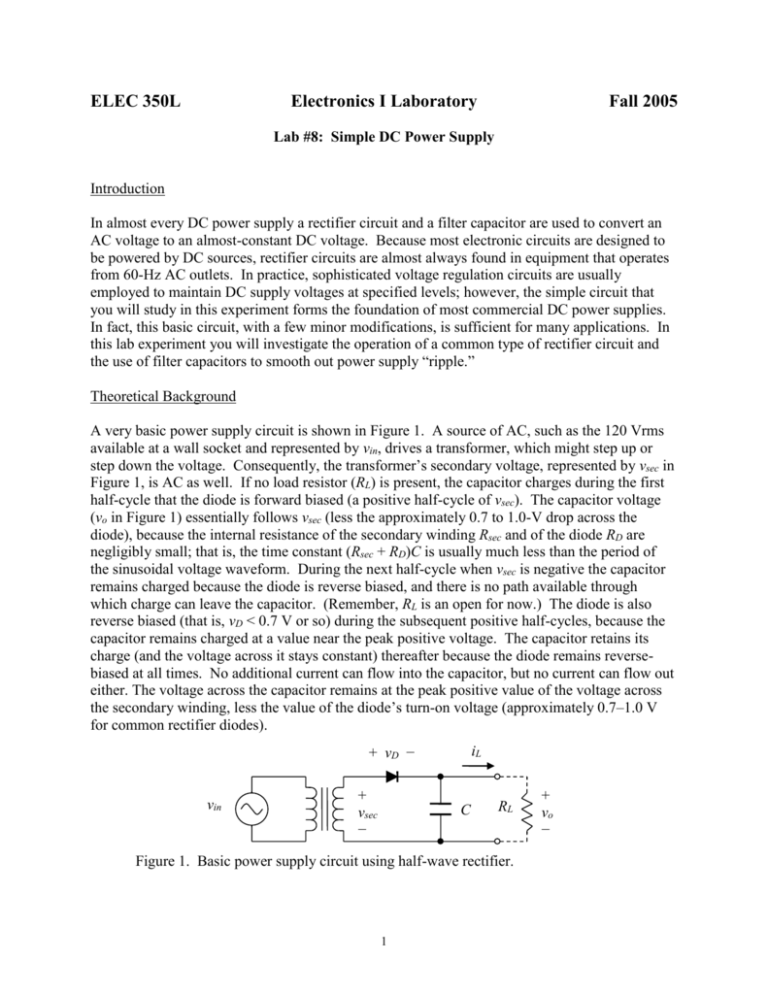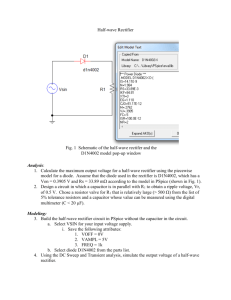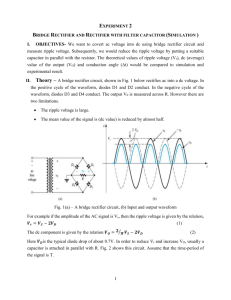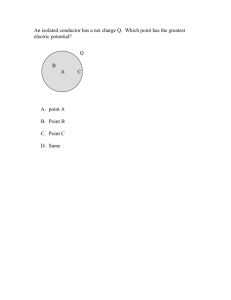Introduction - Facstaff Bucknell
advertisement

ELEC 350L Electronics I Laboratory Fall 2005 Lab #8: Simple DC Power Supply Introduction In almost every DC power supply a rectifier circuit and a filter capacitor are used to convert an AC voltage to an almost-constant DC voltage. Because most electronic circuits are designed to be powered by DC sources, rectifier circuits are almost always found in equipment that operates from 60-Hz AC outlets. In practice, sophisticated voltage regulation circuits are usually employed to maintain DC supply voltages at specified levels; however, the simple circuit that you will study in this experiment forms the foundation of most commercial DC power supplies. In fact, this basic circuit, with a few minor modifications, is sufficient for many applications. In this lab experiment you will investigate the operation of a common type of rectifier circuit and the use of filter capacitors to smooth out power supply “ripple.” Theoretical Background A very basic power supply circuit is shown in Figure 1. A source of AC, such as the 120 Vrms available at a wall socket and represented by vin, drives a transformer, which might step up or step down the voltage. Consequently, the transformer’s secondary voltage, represented by vsec in Figure 1, is AC as well. If no load resistor (RL) is present, the capacitor charges during the first half-cycle that the diode is forward biased (a positive half-cycle of vsec). The capacitor voltage (vo in Figure 1) essentially follows vsec (less the approximately 0.7 to 1.0-V drop across the diode), because the internal resistance of the secondary winding Rsec and of the diode RD are negligibly small; that is, the time constant (Rsec + RD)C is usually much less than the period of the sinusoidal voltage waveform. During the next half-cycle when vsec is negative the capacitor remains charged because the diode is reverse biased, and there is no path available through which charge can leave the capacitor. (Remember, RL is an open for now.) The diode is also reverse biased (that is, vD < 0.7 V or so) during the subsequent positive half-cycles, because the capacitor remains charged at a value near the peak positive voltage. The capacitor retains its charge (and the voltage across it stays constant) thereafter because the diode remains reversebiased at all times. No additional current can flow into the capacitor, but no current can flow out either. The voltage across the capacitor remains at the peak positive value of the voltage across the secondary winding, less the value of the diode’s turn-on voltage (approximately 0.7–1.0 V for common rectifier diodes). + vD − vin + vsec − iL C RL Figure 1. Basic power supply circuit using half-wave rectifier. 1 + vo − Of course, a load (represented by RL) must be connected to this circuit if it is to do any useful work. In this case, vo is no longer constant because the capacitor discharges though the load whenever vsec falls below the level necessary to keep the diode forward-biased. This circuit is called a rectifier, because it allows current to flow in only one direction though the load. Although the load current iL is unidirectional, it nevertheless varies considerably as the capacitor voltage rises and falls. The major disadvantage of the circuit shown in Figure 1 is that the diode conducts during only one of the AC voltage’s half-cycles, and for this reason the circuit is more specifically called a half-wave rectifier. During the half-cycle when the diode does not conduct, the capacitor continues to discharge through the load. The rate of discharge depends on the value of RL. If RL is small enough, the current flowing out of the capacitor is significant. As a result, the voltage across the capacitor can drop to an intolerably low level. The continual charging and discharging of the capacitor causes the output voltage of the power supply to fluctuate, creating what is called a ripple voltage that is superimposed on the average DC output voltage. This effect is shown graphically in Figure 2. Since most applications require a nearly steady supply of DC, the presence of significant ripple is undesirable. The ripple voltage is often expressed as a percentage and is calculated using the formula [1] % ripple 100 peak - to - peak ripple voltage . average DC voltage vout ripple voltage (p-p) average DC value t Figure 2. Ripple voltage in the output of a DC power supply. (Adapted from [1]) This problem is mitigated somewhat by using a full-wave rectifier circuit like the one shown in Figure 3 on the next page. In this circuit, diodes D2 and D4 conduct during positive half-cycles (when vsec is positive), and diodes D1 and D3 conduct during negative half-cycles. Thus, during both half-cycles current flows downward through the load resistor. The full-wave rectifier is an improvement over the half-wave circuit because the capacitor is charged during both half-cycles. Consequently, the capacitor does not have as much time to discharge, and the output voltage 2 does not drop as much. For a given capacitor value the ripple voltage of the full-wave rectifier circuit is much smaller in magnitude than that of the half-wave rectifier. + vin D1 D2 D4 D3 iL vsec − + C iC RL + vo − Figure 3. Full-wave bridge rectifier circuit with filter capacitor. The “+” symbol next to the upper plate of the capacitor indicates that it is an electrolytic type. Electrolytic capacitors are commonly used in power supply circuits because they are available in large values. They are also polarized; that is, the voltage across them must have the indicated polarity for proper operation. The capacitors shown in Figures 1 and 3 are often called filter capacitors because their purpose is to reduce the ripple voltage to a tolerable level. As the sinusoidal input voltage rises to its peak, the capacitor voltage rises with it, as explained earlier. When the input voltage begins to fall again, the capacitor begins to discharge. However, if the capacitor is large enough and if the load resistance isn’t too small, the rate of discharge is much less than the rate at which the input voltage falls. Thus, there will be a period of time during each half-cycle when none of the diodes conduct; that is, all of the diodes are reverse-biased (off). During this time the capacitor and load resistor are effectively isolated from the rest of the power supply circuit, and the capacitor voltage drops exponentially with the time constant RLC as the capacitor discharges through the load. Therefore, in order to keep the ripple voltage down to a tiny fraction of the average DC output voltage level, the time constant is made much larger than the length of a half-cycle. The smaller the load resistance, the larger the value C must have for minimal ripple. The required value of C for a given amount of ripple voltage is easily determined. Recall that the current ic that flows into the top of the filter capacitor is given by ic C dv o , dt where vo is the output voltage, which is equal to the capacitor voltage. If the ripple is a small percentage of the total output voltage, then the voltage across the capacitor decays almost linearly. (See, for example, Figure 2 above or, for a more accurate depiction, Figure 3.29b in the text.) Let vmax be the maximum value of the output voltage and vmin be the minimum value. If the ripple is small, then the decay is very slow, and the capacitor will not start charging again until almost the next time the input voltage reaches a peak. For a full-wave rectifier, the next input voltage peak occurs approximately one half-period (0.5T, where T is the period) later. The time derivative of the output voltage over the half-cycle can therefore be approximated as 3 dv o v v min , max dt 0.5T where the negative sign indicates that the output voltage falls as the capacitor discharges. Substituting this result into the i-v relationship for the capacitor yields ic C dvo v v min C max . dt 0.5T The diodes are off (reverse-biased) when the capacitor discharges, so the only place the capacitor current can flow is through the load resistor. Since ic is defined as flowing into the top of the capacitor, this means that ic = –iL when the capacitor discharges. The change in the output voltage is assumed to be much smaller than the average output voltage; thus, the load current can be approximated as V iL P , RL where VP is the peak output voltage (i.e., the peak capacitor voltage). Substituting this result into the equation for ic above leads to the relationship v vmin VP . i L ic C max RL 0.5T The ripple voltage Vr is defined as the peak-to-peak value of the fluctuation of the output voltage, so Vr = vmax – vmin. Thus, VP V C r . RL 0.5T This can be rearranged as Vr 0.5T . VP RL C The left-hand side is the “fractional” ripple; that is, it is the ripple amplitude expressed as a fraction of the peak output voltage. (For example, if the percentage ripple is 5%, then the fractional ripple is 0.05). The frequency of the input voltage is typically known by the designer, and the load resistance is either also known or can be estimated to a fair degree of accuracy. If this is the case, then the equation can be used to find the required filter capacitor value to achieve a target percentage ripple (or fractional ripple). Using the relationship f = 1/T, we obtain the result 0.5T 1 1 1 C . RL Vr VP 2 f RL Vr VP If the maximum load current is specified rather than the load resistance, we can substitute the relationship RL = VP / iL into the formula for C to obtain 4 C i L ,max i L ,max 1 , 2 f VP Vr VP 2 f Vr where iL,max is used because the capacitor must be large enough to handle the largest expected current demand. Remember that Vr is the actual p-p ripple voltage, not the fractional ripple. The output voltage of the simple DC power supply discussed here is very close to approximately 1.4-2.0 V (two diode drops) below the peak magnitude of vsec. If a certain output voltage level is required for a given application, then a transformer must be selected that has the appropriate peak secondary voltage rating. Experimental Procedure Construct the full-wave bridge rectifier shown in Figure 3. For safety reasons, the transformer is enclosed in a large box with a power cord. There are three jacks on the box that are connected to the secondary winding of the transformer. The two red jacks connect to the ends of the winding, and the green jack connects to a center tap on the winding. For this lab experiment, take the AC voltage for your power supply from the two red jacks. Before connecting the transformer to the rectifier, sketch or plot the AC voltage measured across the secondary winding. Is it sinusoidal? Build the rectifier circuit using four 1N4007 diodes, and allow for load resistor values between 1 k and infinity. Warning: Do not attempt to measure both the AC voltage on the secondary winding and the output voltage across the load resistor at the same time. You could create a ground loop (a short between the two ground leads) that could destroy one or more components. Without a filter capacitor in place, but with RL = 1 k, observe the output waveform on the oscilloscope. Sketch or plot the waveform, and compare it to the plot of the voltage across the secondary winding. Pay particular attention to any “flat” parts of the waveform and any difference in peak values. Explain the differences you observe. Calculate the capacitor value needed to obtain a 4% ripple in the output voltage. From the stock of available capacitors, select one with a value as close as possible but greater than the value you calculated. (Why should it be greater?) With the power off, add the capacitor to the circuit. Warning: Electrolytic capacitors are polarized. Failure to pay attention to their polarity could result in their spectacular destruction and a trip to the hospital for anyone nearby. Note that the markings on the capacitor’s package usually indicate its negative terminal. Reapply power to the circuit, sketch or plot the output waveform for RL = 1 k, and record the nominal DC output voltage and ripple voltage for several values of RL above 1 k. You might have to change the oscilloscope’s coupling setting from DC to AC in order to observe the ripple clearly. Calculate the percentage ripple for each RL value. 5 Comment on the difference (or closeness) between your measured ripple value and the value you predicted for RL = 1 k. Comment on the nominal DC output voltage value relative to the peak value of vsec. That is, explain the relationship between the two. Reference 1. M. Wasserman, Laboratory Manual for Microelectronic Circuits and Devices, 2nd ed., by M. N. Horenstein, Prentice-Hall, Inc., Upper Saddle River, NJ, 1996. 6







